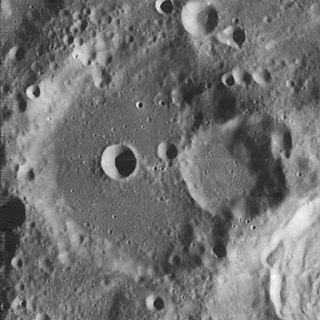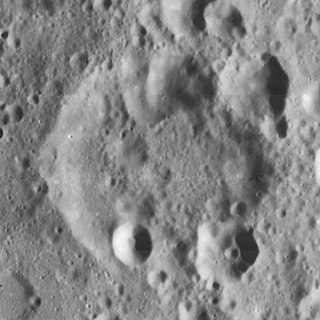
Zagut is a crater located in the heavily impacted southeast sector of the Moon. It is almost surrounded by other named craters, with Wilkins to the northwest, Lindenau to the east, Rabbi Levi in the southeast, and Celsius to the southwest. It is named after Jewish Spanish astronomer and rabbi Abraham Zacuto.

Cleomedes is a prominent lunar impact crater located in the northeast part of the visible Moon, to the north of Mare Crisium. It was named after Greek astronomer Cleomedes. It is surrounded by rough ground with multiple crater impacts. The irregular crater Tralles intrudes into the northwest rim. To the east is Delmotte. North of Cleomedes is a triple-crater formation with Burckhardt occupying the center.

Appleton is a heavily eroded lunar impact crater that lies in the northern hemisphere on the far side of the Moon. To the northwest are the craters Von Neumann and Campbel. The smaller Golovin lies to the northeast, while further to the southwest is the Mare Moscoviense.

Babbage is an ancient lunar impact crater that is located near the northwest limb of the Moon, named after Charles Babbage. It is attached to the southeastern rim of the prominent crater Pythagoras. The crater remnant named South intrudes into the southeastern floor of Babbage.

Boss is a lunar impact crater that is located along the northeast rim of the Moon's near side. Due to its location, the crater is viewed from the side by observers on the Earth, and its visibility is subject to libration effects.

Barrow is an old lunar impact crater that is located near the northern limb of the Moon. It lies between the crater Goldschmidt to the northwest and the irregular formation Meton to the northeast. To the southwest is W. Bond.

Joliot is a large lunar impact crater that lies on the far side of the Moon, just past the eastern limb. At this location it lies in a region of the surface that comes into sight during a favorable libration, although at such times it is viewed from the side. Thus viewing this crater in detail must be done from orbit.

De La Rue is the remnant of a lunar impact crater, or possibly several merged craters, creating a formation sometimes called a walled plain. It lies in the northeastern part of the Moon on the near side, and so appears foreshortened due to its location. This formation lies to the north-northwest of the prominent crater Endymion, just beyond the eastern extreme of Mare Frigoris. The crater Strabo intrudes into the northern part of De La Rue's northern rim, and the smaller Thales is attached to the northwestern part of the wall.

Cepheus is a lunar impact crater that is located in the northeastern part of the Moon, within one crater diameter of the larger crater Franklin to the southeast. To the north-north-east is the flooded crater Oersted. The proximity of this formation to the lunar limb means it appears oblong when viewed from the Earth due to foreshortening.

Fabry is a large lunar impact crater of the form termed a walled plain. It is located on the far side of the Moon, just beyond the northeastern limb. Parts of this area are sometimes brought into view by the effects of libration, but the terrain is seen from the edge and so not much in the way of detail can be observed.

Riccius is a lunar impact crater that is located in the rugged, southeastern part of the Moon's near side. It was named after Italian astronomers Augustinus Riccius and Matteo Ricci. It lies within one crater diameter southeast of the crater Rabbi Levi. To the east-northeast is Stiborius and due south is Nicolai.

d'Alembert is a large lunar impact crater located in the northern hemisphere on the far side of the Moon, to the northeast of the somewhat smaller walled plain Campbell. Astride the southwest rim of d'Alembert is Slipher. To the north is the crater Yamamoto, and to the south-southwest lies Langevin. This walled plain has the same diameter as Clavius on the near side, making it one of the largest such formations on the Moon.
Cooper is a lunar impact crater that is located in the northern hemisphere on the far side of the Moon. It lies to the east of the large walled plain D'Alembert, and west-southwest of the crater Chappell.

Dyson is a lunar impact crater, 63 kilometers in diameter, that lies on the far side of the Moon, past the northwest limb. It is located in the northern part of the surface, to the northwest of the crater Coulomb, and east of van't Hoff.

Charlier is a lunar impact crater that is located on the far side of the Moon. To the south-southeast is the larger crater Kovalevskaya, and northeast of Charlier is Perrine.

Curie is a large lunar impact crater, much of which lies on the far side of the Moon as seen from the Earth. The western rim projects into the near side of the Moon, as defined by the selenographic coordinate system. However the visibility of this formation depends on the effects of libration, so that it can be brought fully into view or completely hidden depending on the orientation of the Moon. When visible, however, it is seen nearly from the side, limiting the amount of detail that can be observed.

Comstock is a lunar impact crater that is located on the far side of the Moon. It lies to the northeast of the walled plain Fersman, and north of the crater Weyl.

Comrie is a lunar impact crater. It is located on the rugged far side of the Moon relative to the Earth, beyond the western limb. Nearby craters of note include Ohm to the south-southwest, Shternberg to the southwest, and Parenago to the northeast.

Joule is a lunar impact crater that lies on the far side of the Moon. It is located to the north-northeast of the walled plain Mach. To the northwest of Joule is the crater Blazhko.

Strömgren is a lunar impact crater that is located on the far side of the Moon from the Earth. It lies less than one crater diameter to the north-northeast of Von der Pahlen. Farther to the east is Gerasimovich, and to the north-northeast is Belopol'skiy.



















